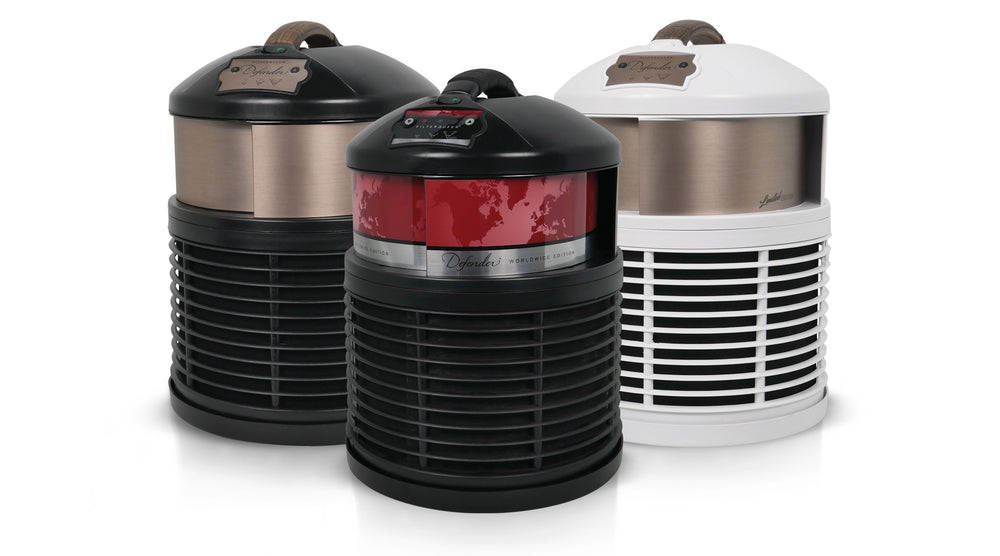What to Look for When Choosing a Portable Air Purifier

If you’re reading this article, it probably means you’re researching whether or not to purchase a portable air purifier. Congratulations on taking the first step to breathing cleaner, healthier air! Investing in a high-quality air purifier can be an integral part of an effective strategy to improve the indoor air quality in homes, offices or any other enclosed spaces. The effectiveness varies greatly depending on which air purifier you choose, so let’s break down everything you need to know about choosing the best portable air purifier for your needs.
How Important is it to Have a Portable Air Purifier?
Indoor air quality is serious business. The increase of pollution and smog outside gets a lot of press – and rightly so – but it seems that no one aside from the EPA is letting you know that the air you’re breathing while inside can be 3-5 times worse (there are also studies showing indoor pollution levels can be up to 100 times higher than the air outdoors).
These statistics alone sound scary but it only becomes more daunting when you consider that on average, we spend 90% of our time indoors. Between sleeping, cooking, watching television, and working from home, that's a lot of time spent breathing harmful airborne particles and gasses that can be detrimental to our health.
The news isn’t all bleak. By simply opening a window and making sure your indoor area is well ventilated, you can greatly increase your indoor air quality by providing a constant flow of fresh air. Unfortunately, due to poor weather, no access to windows, or high pollen levels outside, that may not be possible. In all these situations, investing in a portable air purifier can be your best, and sometimes only, line of defense.
What Should I Look For When Choosing a Portable Air Purifier?
VOCs
VOC stands for Volatile Organic Compounds. VOCs are gasses emitted from certain solids or liquids that include many cleaning products that we see in regular home use, along with paints and furniture. These VOCs are toxic and require an air purifier that can target these airborne gasses.
CADR
MERV
Minimum Efficiency Reporting Value or MERV rating. This measurement, used by the American Society of Heating, Refrigerating, and Air Conditioning Engineers (ASHRAE), measures the fraction of particles removed from air passing through a filter. This measurement is on a scale of 1-20 (1 being the lowest efficiency) and is the most accurate measurement when it comes to measuring the efficacy of a portable air purifier.
HEPA
What Should I Avoid?
Avoid ozone generators, ionizers, and anything that uses UV light.
As the name suggests, ozone generators… generate ozone. This ozone can create throat irritation, coughing, chest pain, and shortness of breath. If that isn’t enough to dissuade you, ozone also increases your risk of respiratory infections, and the state of California has long banned any air purifier that produces ozone.
Ionizers are mostly useless as all they accomplish is making the particles in the air attach to surfaces just for them to be dislodged and reenter the air. They also increase unwanted contaminants such as acetone, ethanol and toluene into the air, so it’s best to avoid them.
Lastly, the EPA specifically lists several disadvantages of using UV technology in a portable room air purifier, including risk of eye injury, generating ozone, high power requirements, and diminishing effectiveness in smaller portable units.
Extremely small portable air purifiers such as desk units or those purifiers that look like those plug in the wall scent generators are next to useless. The efficacy of these units goes down the smaller they are. They also have less power due to the simple fact that they cannot draw in enough air in the room.
What is the Best Portable Air Purifier?
In summary, you want to pick an air purifier that eliminates both airborne particles and VOCs, as those are what cause poor indoor air quality.
The FilterQueen Defender has superb filtration that starts with the Enviropure Activated Charcoal Wrap that is highly effective at removing harmful pollutants and odors, such as VOCs, cigarette smoke, and more. The air then passes through the MERV 19 rated Medi-Filter Cartridge, which provides three times better-than-HEPA filtration to remove harmful airborne pollutants, such as dust mites, mold spores, viruses, bacteria, pet dander, airborne chemicals and more.
The Defender is quiet and runs 24/7, which means you will have peace of mind knowing the air in your space is constantly being purified. FilterQueen takes the guesswork out of finding the best air purifier for your home or office, so you can relax and breathe easy.
By Ryan Duggan
The best portable air purifier.



